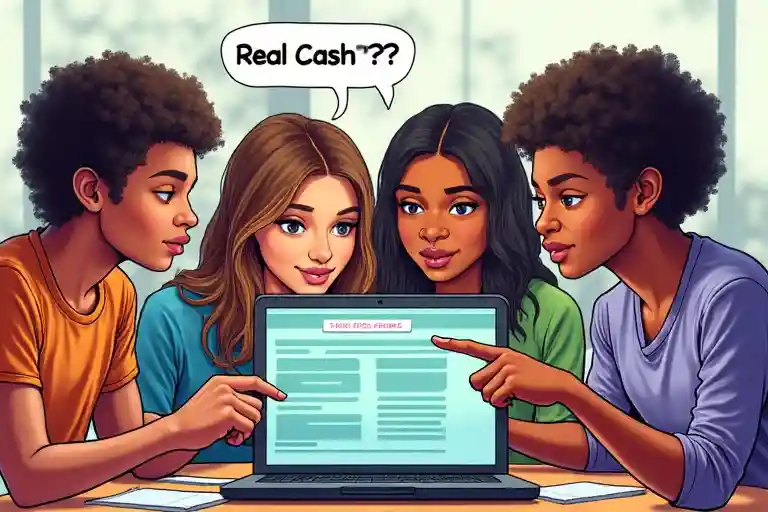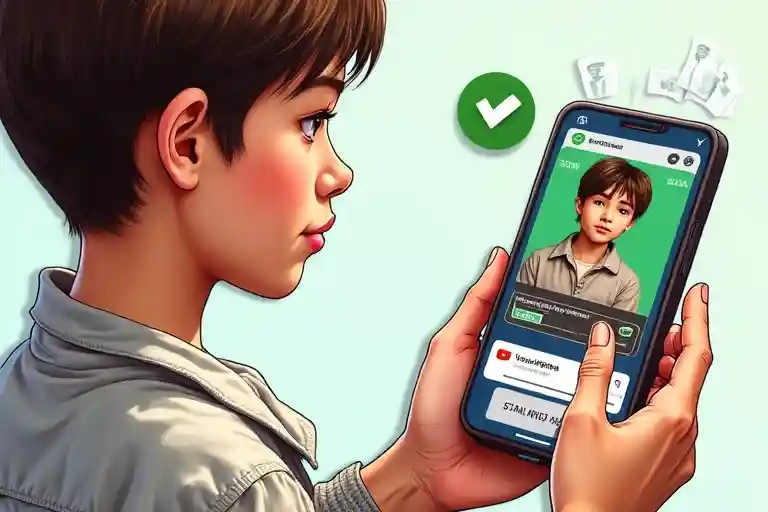Last updated: June 2025
Alright, let’s dive straight in! You’ve probably scrolled past a million TikToks promising easy money, right? And maybe you’ve stumbled upon the idea of get paid to click websites. The promise is tempting: click on ads, watch short videos, or complete tiny tasks, and BAM! Money in your (virtual) pocket. But here’s the million-dollar question (or maybe just a few cents question): Is this for real, especially for us teens, or is it just another one of those internet things that sounds too good to be true? I was super curious myself, and what I found was a mixed bag – kinda like those mystery flavor Airheads, you never *really* know what you’re gonna get until you try (or in this case, research!). This article is going to break down what these get paid to click websites are all about, how you can (maybe) make some pocket money, which platforms might be worth your screen time, and most importantly, how to stay safe and avoid the sketchy corners of the web. We’ll look at real examples, talk about what’s actually doable for someone between 13 and 18, and even explore how to tell if a site is legit or if it’s about to ghost you harder than your crush after you triple-texted. So, grab your notes app, and let’s figure out if clicking for cash is a YAY or a NAY!
Understanding How “Get Paid to Click Websites” Really Work
So, what’s the actual deal with these get paid to click websites? Think of them as middlemen. On one side, you have advertisers – companies that want people to see their products, services, or websites. On the other side, you have users (that’s you!) who are willing to view these ads for a small payment. The Paid-to-Click (PTC) website connects these two groups. Advertisers pay the PTC site to display their ads, and the PTC site then shares a tiny fraction of that money with users who click on those ads. It sounds simple, and in theory, it is. You click, you (eventually) earn. But the earnings per click are usually *super* small – we’re talking fractions of a cent sometimes! This is a bit different from ad click earn money websites that might offer slightly different models, but the core idea of getting paid for interacting with ads is similar. The main appeal for advertisers is getting eyeballs on their content, hoping that some of those views will convert into actual customers or users. For users, especially teens looking for ways to earn without a traditional job, it seems like an easy entry point. No special skills are usually needed, just time and an internet connection. However, it’s crucial to understand that “easy” doesn’t always mean “profitable” or “safe.” We’ll get more into the nitty-gritty of earnings and safety later, but knowing the basic mechanics helps you see why these sites exist in the first place. It’s not magic money; it’s a business model, and like any model, it has its ups and downs.
Why Would Anyone Pay You Just to Click?
This is a super valid question! It might seem weird that someone would just hand over cash for a simple click. The truth is, advertisers are always looking for ways to get their message out there. They might be launching a new app, promoting a sale, or just trying to increase brand awareness. By using get paid to click websites, they hope to drive traffic to their sites. Now, whether this traffic is *quality* traffic is a whole other debate. Often, people clicking on these ads are just there for the reward and might not be genuinely interested in the product. This is something that some industry blogs highlight as a problem for marketers. However, for some advertisers, even this low-engagement traffic might be part of a broader strategy, or they might be hoping that a small percentage of clickers *do* become interested. For users, it’s an exchange of your time and attention for a small monetary reward. Think of it like those super short ads you have to watch before a YouTube video, except you’re actively seeking them out and getting a tiny kickback. It’s less about the value of your single click and more about the volume of clicks these platforms can generate.
Different Types of Tasks on PTC Sites
It’s not always *just* clicking ads. Many get paid to click websites have diversified to keep users engaged (and clicking!). You might find a variety of micro-tasks, such as:
- Viewing Ads: The classic PTC task. You click an ad, wait for a timer (usually 5-30 seconds), and earn a tiny amount.
- Watching Videos: Similar to viewing ads, but you’ll watch short video clips.
- Completing Short Surveys: Some PTC sites partner with market research companies. These usually pay a bit more than just clicks but take more time.
- Playing Games: Earn points or small amounts for reaching certain levels or spending time in online games.
- Signing up for Offers: This can involve registering on other websites or trying out services. Be VERY careful with these, as they can sometimes lead to spam or unwanted subscriptions. Parental guidance is a BIG must here.
- Micro-Tasks: These could be anything from categorizing images to verifying information. They require a bit more effort but might offer slightly better rewards. Platforms like JumpTask, as mentioned in their article on GPT sites, often combine various task types.
Each type of task will have different payout rates and time commitments. It’s like choosing your character in a game – some are quick and agile (like basic ad clicks), while others are slower but might yield more rewards (like surveys or detailed offers). Always check the requirements and potential payout before diving in!
Get paid to click websites legit: Fact or Fiction?
Okay, real talk time. Are get paid to click websites legit? The answer is… complicated. It’s like asking if all social media influencers are genuine – some are, and some are definitely just selling you snake oil with a fancy filter. There *are* legitimate PTC sites out there that do pay their users. However, the internet is also a wild jungle, and it’s CRAWLING with scam sites that will happily waste your time, or worse, try to snatch your personal information. The key is learning how to tell the difference. Legit PTC sites usually have realistic earning claims (pennies per click, not dollars), clear terms of service, and a history of actually paying out. They are often transparent about how they work. Scam sites, on the other hand, might promise ridiculously high payouts (like the “get paid $10 to click ads” dream – spoiler: mostly a dream), have shady contact information, or suddenly disappear when it’s time to cash out. Remember that PTC sites online earning legit status often depends on managing expectations and doing thorough research before you invest any time. The truth is, you’re not going to get rich quick, or even slow, from most of these platforms. It’s more about earning a tiny bit of extra pocket money if you have spare time and enjoy mindlessly clicking while listening to music. But, as many sources including an article on whether PTC sites are worth it point out, the time investment versus reward is often very low.
Red Flags: How to Spot a Scam PTC Site
Alright, teens, put on your detective hats! Spotting scam get paid to click websites is a crucial skill. It’s like trying to figure out if that online “friend” is really who they say they are. Here are some major red flags that should make you go “Hmm, that’s sus!”:
- Too Good to Be True Promises: If a site screams “EARN $50 AN HOUR CLICKING ADS!!!” – run! Legit PTC earnings are tiny. If it sounds like a fantasy, it probably is.
- Upfront Fees or Investment: Some scam sites ask you to pay for “premium membership” or “referral packages” with the promise of higher earnings. BIG NOPE. You shouldn’t have to pay money to earn money by clicking ads.
- No Contact Information or Vague Details: If you can’t find a clear “About Us” page, physical address (even if it’s just a registered business), or reliable contact info, be wary. Sketchy sites love to hide.
- Poor Website Design and Lots of Errors: A legit business usually invests in a decent website. If it looks like it was made in 5 minutes by a toddler on a sugar rush, with broken links and tons of typos, that’s a bad sign.
- High Minimum Payout Thresholds with Complicated Rules: Some sites set the minimum amount you need to earn before you can cash out incredibly high, making it almost impossible to reach. Or they have super complex rules designed to make you give up.
- Loads of Negative Reviews (or ONLY Positive Ones): Do a quick Google search for “[Site Name] reviews” or “[Site Name] scam.” If you see a flood of complaints about not getting paid, that’s a huge warning. Conversely, if ALL reviews are glowing and sound suspiciously similar (like written by bots), that’s also a red flag.
- Asking for TOO Much Personal Info: You’ll need to provide some info to get paid (like a PayPal email), but if they’re asking for your bank account password or your social security number right off the bat for simple clicking tasks, ABORT MISSION!
Trust your gut! If something feels off about a get paid to click websites, it probably is. It’s always better to be safe than sorry, especially when your time and potentially your data are on the line. For more insights into PaidToClick: Safe Ways for Teens to Earn, always prioritize platforms with transparent practices.

Get paid to click websites for free: Is It Really Free?
Yes, the core idea of most get paid to click websites for free is that you don’t have to pay any money to join or to start clicking and earning. That’s the “unfastened” element. You sign up, you click, you (with a bit of luck) earn. However, “free” does not imply there is no price at all. The predominant “value” is your TIME. And let me tell you, a while is valuable! Think about it: in case you spend an hour clicking and earn, say, 50 cents, become that the great use of your hour? Maybe, in case you have been just chilling and had nothing else to do. But if you could have spent that hour learning a brand new ability, doing homework, or maybe some thing more beneficial like on-line freelancing (if you’re vintage sufficient and feature skills), then the “possibility price” is high. Also, be cautious of sites that begin loose however then heavily push you to “upgrade” your account via paying a charge for supposedly higher earning rates or extra commercials. While a few legit websites may provide optional enhancements, they ought to in no way be a requirement to earn something. The honestly loose ones can help you earn, but little, without ever soliciting for your credit score card. So, while you’re not paying with cash, you’re definitely paying with your time and attention. Make sure that trade-off feels worth it to you. Consider exploring some best PTC sites earn money options that are genuinely free to join.
Get paid $10 to click ads: The Unicorn of PTC?
Ah, the legendary “Get paid $10 to click ads” promise! This is like locating a glittery Pokémon in your first strive – extremely uncommon and often just a rumor. Let’s be brutally sincere: locating a legitimate internet site so one can pay you $10 for a unmarried ad click is tremendously, especially not likely. Most PTC websites pay fractions of a cent to 3 cents in step with click. If you notice a website making the sort of bold declare, your rip-off alert ought to be BLARING like a hearth alarm. Why? Because it is just no longer a sustainable commercial enterprise model for them. Advertisers aren’t paying PTC sites enough for them to then flip round and come up with $10 for one observe an advert. These sorts of offers are almost continually traps. They might be seeking to:
- Lure you in to get your personal information.
- Make you complete an endless series of “tasks” or “surveys” that never actually lead to the $10 payout.
- Get you to refer a huge number of people before you can “unlock” this amazing earning rate (which then never materializes).
- Install malware on your device.
Think about it – if it were that easy to make $10 per click, wouldn’t everyone be doing it? The internet would be a very different place! Instead of chasing these unicorns, it’s better to focus on understanding the realistic earning potential of best get paid to click sites, which is usually modest. It’s about small, consistent earnings, not massive windfalls.
Pay per click sites make money online: How Much Can Teens Realistically Earn?
So, you’re looking at pay per click sites make money online and wondering, “Okay, skip the hype, what’s the real deal for a teen like me?” Let’s be straight up: you are NOT going to buy a new gaming console or the latest iPhone with PTC earnings alone. It’s more like “a bit of extra cash for snacks” or “saving up for a new game over a *long* time” money. The amount you can earn depends on several factors:
- The specific PTC site: Payout rates vary wildly. Some are slightly better than others.
- The number of ads available: You can only click what’s there! Sometimes ads are limited.
- The time you dedicate: Obviously, the more time you spend (responsibly!), the more clicks you can make.
- Referral programs: Some sites offer a small commission if you refer friends. This can boost earnings, but don’t annoy your mates by spamming them! (And remember, as this Quora thread discusses, trying to cheat referral systems is a bad idea and can get you banned.)
- Tasks beyond clicks: If you do surveys or other micro-tasks (which some get paid to click sites offer), your earnings might be slightly higher, but so is the time commitment.
Realistically, active users might earn a few dollars a month. Yes, *a month*. If a site promises hundreds, be very skeptical. It’s essential to go in with super low expectations regarding income. Think of it as a way to monetize truly idle moments, not as a replacement for a part-time job or even more lucrative online hustles if you have the skills (like graphic design, writing, or coding, which you can often learn online for free!).
Comparison of Potential Earning Methods for Teens
To put get paid to click websites into perspective, let’s look at a (very general) comparison table for teens. Income potential is highly variable and these are just rough estimates!
| Earning Method | Typical Age Requirement (may vary) | Skill Level Needed | Time Investment | Potential Income (Roughly) | Parental Consent Often Needed? |
|---|---|---|---|---|---|
| PTC Websites | 13+ (some sites) | Very Low | Varies, can be high for low return | Very Low ($1-$10/month) | Yes, highly recommended |
| Online Surveys | 13+ (some sites) | Low | Medium | Low ($10-$50/month) | Yes |
| Freelancing (e.g., writing, simple graphic design, social media help for small businesses) | 13-16+ (with parent’s account on some platforms) | Medium to High | Medium to High | Medium to High ($50-$500+/month, very variable) | Yes, often required by platforms |
| Babysitting/Pet Sitting | 13+ (often informal) | Low to Medium | Varies | Medium ($10-$20/hour locally) | Yes (for arrangements) |
| Selling Crafts/Art Online (e.g., Etsy with parental help) | Under 18 with parent account | Medium (talent-based) | High (creation + marketing) | Varies widely | Yes, for platform use |
This table shows that while PTC sites are accessible, their income potential is at the lower end. It’s always good to explore different options and see what fits your skills, time, and goals. And always, *always* talk to your parents or a trusted adult before starting any online earning venture.
How to make money online for beginners: Are PTC Sites a Good Start?
If you’re dipping your toes into “how to make money online for beginners,” get paid to click websites can *seem* like an easy first step. They don’t require special skills, you can often start young (with parental permission, of course!), and the concept is straightforward. This low barrier to entry is definitely appealing. You get a little taste of what it’s like to earn money through the internet. However, whether it’s a *good* start depends on your goals. If your goal is to learn about online safety, how online advertising kind of works (from a user perspective), and to earn a tiny bit of cash with minimal effort during downtime, then maybe. But, if your goal is to earn significant money or develop valuable skills, then PTC sites are probably not the best launching pad. The time you spend clicking for pennies could potentially be invested in learning skills like basic coding, graphic design, video editing, or content writing – skills that can lead to much more lucrative online opportunities as you get older and more experienced. Think of PTC sites as maybe the tutorial level of making money online. It’s simple, you learn the basic controls, but you won’t get far in the actual “game” of online income with just that. For truly beginner-friendly ways to make more substantial income, you might explore options listed by some paying PTC sites earn cash resources that sometimes branch into other micro-task platforms.
Safety First: Spotting Scams and Staying Secure on “Get Paid to Click Websites”
This is THE most important part, especially for teens. Navigating get paid to click websites means being super aware of online safety. It’s like walking through a new city – you need to know which streets are safe and which to avoid. Here are key safety tips:
- Parental Guidance, Always!: Before you even THINK about signing up for any site, talk to your parents or a trusted guardian. Show them the website, discuss the pros and cons. Their experience can be invaluable, and they need to know what you’re doing online. This isn’t just a suggestion; it’s a MUST.
- Strong, Unique Passwords: Don’t use the same password you use for your TikTok or school email. Create a strong, unique password for each PTC site. Consider using a password manager (with your parents’ help to set it up).
- Beware of Downloads: If a PTC site asks you to download software to “earn more” or “view special ads,” be EXTREMELY cautious. These downloads could contain malware or spyware. Stick to browser-based activities unless you are 1000% sure (and your parents have vetted it).
- Don’t Overshare Personal Information: You’ll likely need to provide an email for PayPal or another payment processor to get paid. But sites shouldn’t need your home address, phone number (unless for verification with a legit platform, again, with parental oversight), or sensitive financial details beyond your payment processor ID.
- Use a Separate Email Address: Consider creating a new email address specifically for PTC sites. This can help keep your primary inbox clean from potential spam.
- Check Reviews and Reputation: Before signing up, Google the site’s name + “review,” “scam,” or “legit.” See what other users are saying on forums or review sites. Are people actually getting paid? Are there lots of complaints? This research is vital.
- Understand Payment Thresholds and Methods: Know how much you need to earn before you can cash out and what payment methods they use (e.g., PayPal, gift cards). Some less reputable sites make it nearly impossible to reach the payout. Look for information on how website paid-to-click works regarding payments to understand common practices.
- Be Wary of “Too Good To Be True” Offers: As we’ve said, if it sounds unbelievable, it probably is. That “Win an iPhone for clicking 10 ads!” is almost certainly a scam.
- Keep Your Antivirus Updated: Make sure your computer or phone has up-to-date antivirus software. This is just good general internet hygiene!
Remember, your online safety is way more valuable than a few extra cents. If a site makes you feel uncomfortable or seems sketchy, just leave. There are plenty of fish in the sea, and plenty of (mostly tiny-paying) PTC sites.
Maximizing Your Earnings on “Get Paid to Click Websites”: Pro Tips for Teens
So you’ve decided to give get paid to click websites a try, you’ve got your parents’ blessing, and you’re armed with safety knowledge. How can you make the most of it (while keeping expectations realistic)? Here are a few “pro-ish” tips:
- Consistency is Key (If You Choose To): If you’re going to do it, try to be consistent. Some sites offer small daily bonuses for activity. But don’t let it take over your life or important tasks like homework!
- Focus on Reputable Sites: Don’t spread yourself too thin across dozens of potentially scammy sites. Find 2-3 well-reviewed, established PTC sites and stick with them. This makes it easier to reach payout thresholds. Research best paid to click sites to find potentially more reliable options.
- Utilize Referral Programs (Wisely): If you have friends who are *also* interested (and also have parental permission!), you can share your referral link. But don’t be spammy! Explain it honestly, including the low earning potential.
- Check for Tasks Beyond Clicks: Sometimes, short surveys, watching videos, or other micro-tasks on the same PTC platform can pay slightly more than just clicking ads. Explore these if you have the time and patience.
- Set Realistic Goals: Don’t expect to get rich. Set a small, achievable goal, like earning enough for a coffee or a digital game item. This can make the process feel more rewarding.
- Track Your Time vs. Earnings: Occasionally, take stock of how much time you’re spending versus how much you’re earning. Is it still worth it to you? Your time has value! Maybe that hour could be spent learning a new TikTok dance that actually *could* go viral (you never know!).
- Cash Out As Soon As You Meet the Minimum: Don’t let large amounts of money accumulate on these sites, especially newer or less proven ones. Once you reach the minimum payout, cash out to your PayPal or chosen payment method. This reduces your risk if the site suddenly goes offline. This is a good tip for anyone looking to get paid for clicking ads.
- Don’t Be Afraid to Ditch a Site: If a site becomes unreliable, changes its terms unfavorably, or just isn’t providing enough ads, don’t hesitate to stop using it. Your loyalty should be to your own time and effort.
Remember, using get paid to click websites is a marathon (a very, very slow one), not a sprint. Patience and realistic expectations are your best friends here.
Last updated: June 2025
Exploring get paid to click websites can be an interesting first look into online earning for teens, but it’s crucial to approach it with a healthy dose of skepticism and a strong focus on safety. The earnings are typically very small, and the time investment can be significant. Always prioritize your online security, get your parents’ guidance, and never expect to get rich quick. These platforms are best viewed as a way to monetize truly idle moments, rather than a serious income strategy. If you’re looking to earn more substantially or build valuable skills, there are likely better avenues to explore. The most important takeaway? Your time and safety are paramount, so click wisely if you choose to click at all after understanding how get paid to click websites work!

Conclusion
So, there you have it – the lowdown on get paid to click websites for teens. As we’ve seen, it’s not a straightforward path to riches (not even close!), but it can be a way to earn a tiny bit of pocket money if you’re super careful, patient, and have realistic expectations. The most critical things are to always involve your parents, prioritize your online safety above everything else, and understand that your time is valuable. While the idea of getting paid for something as simple as clicking is tempting, the rewards are often minimal compared to the time invested. It’s a world with both legitimate platforms and, unfortunately, many scams. Therefore, being able to spot red flags is a superpower! Consider if the time spent on these sites could be better used learning a new skill that could open up more significant earning opportunities in the future. Ultimately, the decision to explore get paid to click websites is yours (with your parents’ okay!), but go in with your eyes wide open.
What do you think? Have you tried any get paid to click websites? Share your experiences (the good, the bad, and the sketchy) in the comments below! And if you found this article helpful, don’t forget to share it with your friends on TikTok or Instagram – let’s help everyone stay safe and informed online!
Stay Updated! The online world changes FAST. New platforms pop up, and old ones change their rules (or disappear!). Keep checking back on zana.website for the latest info on safe ways for teens to earn online and updates on regulations or new opportunities.
Frequently Asked Questions
1. Do you get paid for website clicks?
Yes, you can get paid for website clicks through Paid-to-Click (PTC) websites. However, the payment per click is typically very small, often fractions of a cent. It’s a way to earn a little extra money in your spare time, but not a significant income source. Always research PTC sites for legitimacy before starting.
2. Which website pays for clicks?
Many websites claim to pay for clicks, known as PTC (Paid-to-Click) sites. Some long-standing examples include Neobux and Scarlet-Clicks, though their earning potential is low. It’s crucial to research any PTC site for legitimacy and payment proofs before investing time, as scam sites are common in this space.
3. Which website gives you real money?
Legitimate Paid-to-Click (PTC) sites can give you real money, usually through PayPal or gift cards, but earnings are very modest. Always verify a site’s reputation and payment history through user reviews. Be cautious of sites promising high payouts, as they are often scams. Focus on established platforms if you choose to engage.
4. Can you get paid for website traffic?
Yes, if you own a website, you can get paid for website traffic through advertising networks like Google AdSense or by selling ad space directly. For users without websites, PTC (Paid-to-Click) sites offer payments for clicking ads, but this generates traffic for advertisers, and your earnings are a tiny fraction of what advertisers pay.









